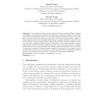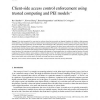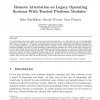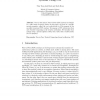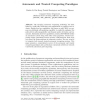JUCS
2010
14 years 4 months ago
2010
: The advances and adoption of Trusted Computing and hardware assisted virtualisation technologies in standard PC platforms promise new approaches in building a robust virtualisati...
JHSN
2006
14 years 5 months ago
2006
It has been recognized for some time that software alone does not provide an adequate foundation for building a high-assurance trusted platform. The emergence of industry-standard ...
JCP
2008
14 years 5 months ago
2008
Trusted computing platforms have been proposed as a promising approach to enhance the security of general-purpose computing systems. Direct Anonymous Attestation(DAA) is a scheme t...
CORR
2006
Springer
14 years 5 months ago
2006
Springer
Due to the convergence of various mobile access technologies like UMTS, WLAN, and WiMax the need for a new supporting infrastructure arises. This infrastructure should be able to ...
ENTCS
2008
14 years 5 months ago
2008
A lot of progress has been made to secure network communication, e.g., through the use of cryptographic algorithms. However, this offers only a partial solution as long as the com...
ESORICS
2010
Springer
14 years 6 months ago
2010
Springer
Due to their nature, Peer-to-Peer (P2P) systems are subject to a wide range of security issues. In this paper, we focus on a specific security property, called the root authenticit...
SEC
2004
14 years 7 months ago
2004
Trusted Computing gives rise to a new supply of trusted third parties on which distributed systems can potentially rely. They are the secure system components (hardware and softwa...
FORTE
2004
14 years 7 months ago
2004
Abstract. As its name indicates, NGSCB aims to be the "Next-Generation Secure Computing Base". As envisioned in the context of Trusted Computing initiatives, NGSCB provid...
ATC
2006
Springer
14 years 7 months ago
2006
Springer
The emerging autonomic computing technology has been hailed by world-wide researchers and professionals in academia and industry. Besides four key capabilities, well known as self-...
ASPLOS
2008
ACM
14 years 7 months ago
2008
ACM
We explore the extent to which newly available CPU-based security technology can reduce the Trusted Computing Base (TCB) for security-sensitive applications. We find that although...
